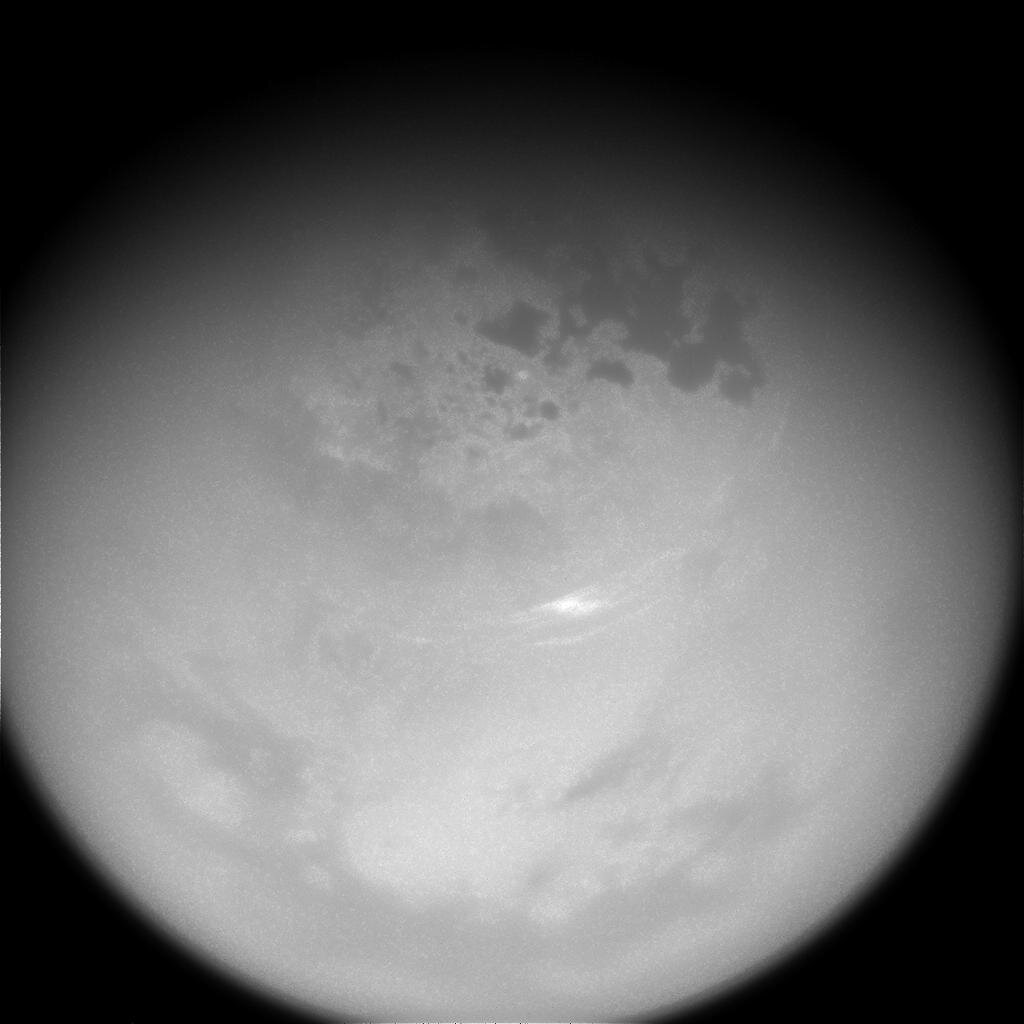Caltech Space Challenge 2022
"Beyond Earth, are there contemporary habitats elsewhere in the universe with necessary conditions to sustain life and do organisms live there now? [Planetary Science Decadal Survey 2011]" This question has intrigued mankind for centuries yet the answer remains unknown up to the present day. It is therefore not surprising that the most recent planetary science decadal survey lists the search for life in our own solar system among the key scientific questions for space missions in the near future.
Clouds above the hydrocarbon lakes in the north polar region of Titan are visible in this image captured by the Cassini spacecraft. Image credit: NASA / JPL / Space Science Institute
The search for life is one of the main drivers behind planetary exploration, motivating our continued interest in Mars as well as bodies such as Europa, Enceladus, and Titan. Presently, most efforts are focused on the presence of liquid water underneath the surface of satellite bodies in the solar system. For the Caltech Space Challenge 2022, our approach will be different - we will analyze liquid lakes on the surface of Titan using state- of-the-art scientific equipment.
Titan has several qualities that make it a unique candidate worthy of ex- ploration in our search for life within the solar system. Besides Earth, Titan is the only other planetary body where there is clear evidence of stable bodies of surface liquid as well as subsurface oceans. The only difference is that these lakes contain methane and ethane. This means that Titan has an active methane-based hydrologic cycle. Titan’s methane-based hydrologic cycle is analogue to Earth’s water cycle, which suggests that a different type of life form, based on methane instead of carbon, may exist. These life forms would inhale hydrogen instead of oxygen and exhale methane instead of carbon dioxide.
The Caltech Space Challenge 2022 mission will include a sample return in addition to in-situ measurements to enable a detailed analysis of the samples. The students will have to decide how to collect the sample and how to safely contain it for their ascent from Titan and the return journey back to Earth. To design the optimal mission concept, the students will have to be creative and work on questions such as orbital trajectory, power management, communication, sample integrity, and economic feasibility. Although the mission itself focuses on Titan, many of the concepts examined will apply to space exploration in general and serve as a thought-provoking stimulant for the community.
We look forward to building on the success of 2011, 2013, 2015, 2017, and 2019 events with the 2022 Caltech Space Challenge: Titan Sample Return.
These images from the radar instrument aboard NASA's Cassini spacecraft show the evolution of a transient feature in the large hydrocarbon sea named Ligeia Mare on Saturn's moon Titan. Image credit: NASA/JPL-Caltech/ASI/Cornell
Participants of the 2017 Caltech Space Challenge on the JPL tour.
In addition to this, it is the only moon in the solar system with an atmosphere that consists of more than just trace gases. It is made up of nitrogen, methane, and small amounts of carbon-rich compounds. This is similar to the early history of Earth, where instead of oxygen, the atmosphere consists of methane. Furthermore, in the upper layers of Titan’s atmosphere, methane and nitrogen molecules are decomposed by the sun’s UV rays and recombined into several organic chemicals, including oxygen and nitrogen. These elements are essential to life as we know it.
The complex chemistry and similarity to an early Earth make Titan a prime candidate for exploration on our quest in search of life in the solar system.
The Caltech Space Challenge was started in 2011 by Caltech graduate students Prakhar Mehrotra and Jonathan Mihaly and was hosted by the Keck Institute for Space Studies (KISS) and the Graduate Aerospace Laboratories at Caltech (GALCIT). Participants of the 2011 challenge designed a crewed mission to a Near-Earth Object (NEO). The second edition of the Caltech Space Challenge, held in 2013, developed a crewed mission to a Martian moon. In 2015, participants of the third Caltech Space Challenge were asked to design a mission that would land humans on an asteroid brought into Lunar orbit, extract the asteroid’s resources and demonstrate their use. The fourth edition, held in 2017, challenged participants with the design of Lunarport, a launch and supply station on the Moon for deep space missions. In 2019, the fifth edition of the Caltech Space Challenges, the participants were asked to design a mission to land in the tiger stripe region of Enceladus and use a distributed lander system to maximize the science gains.













